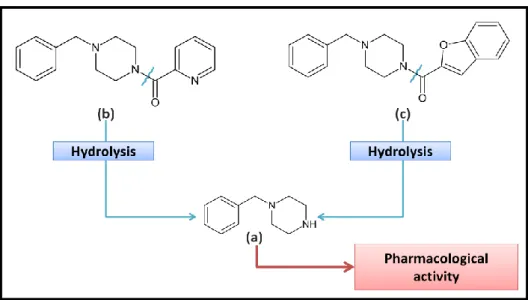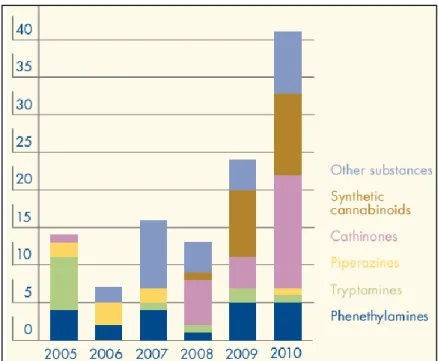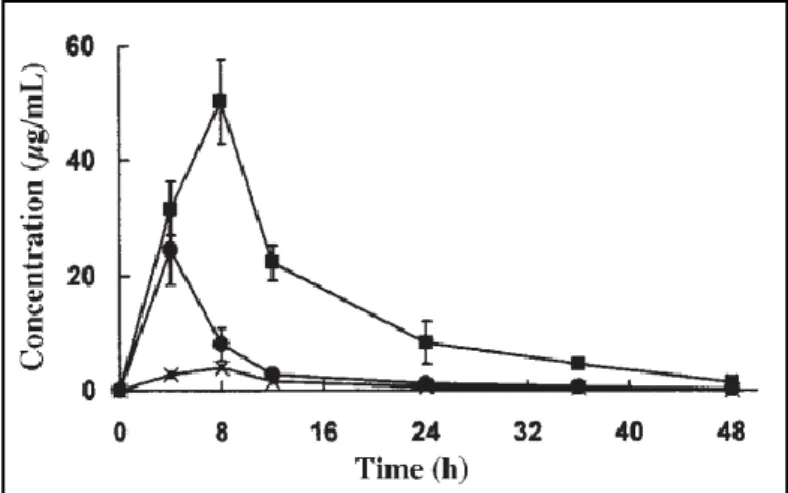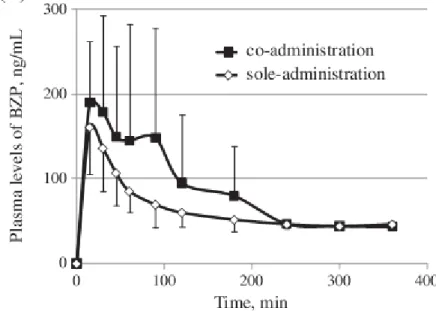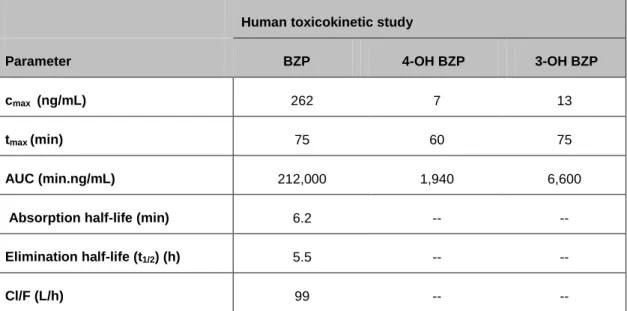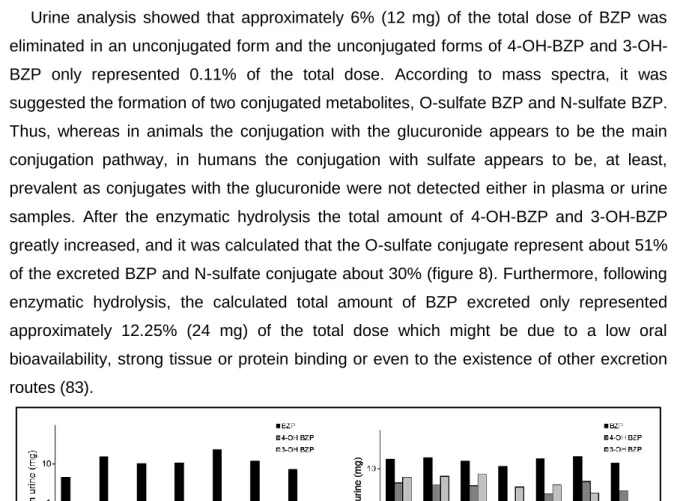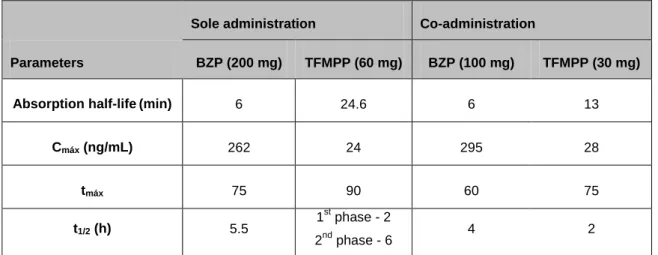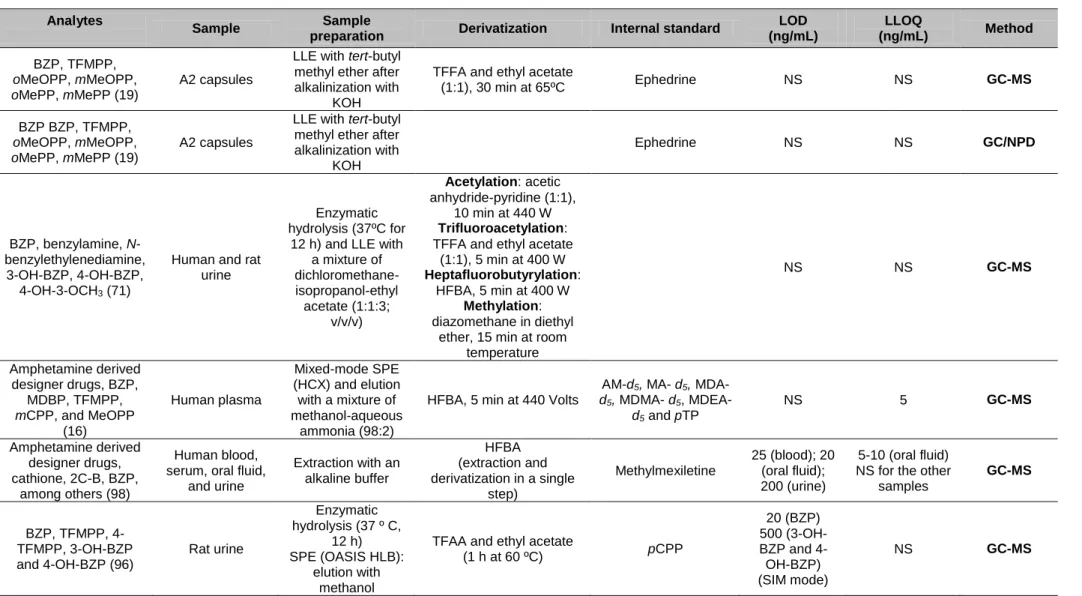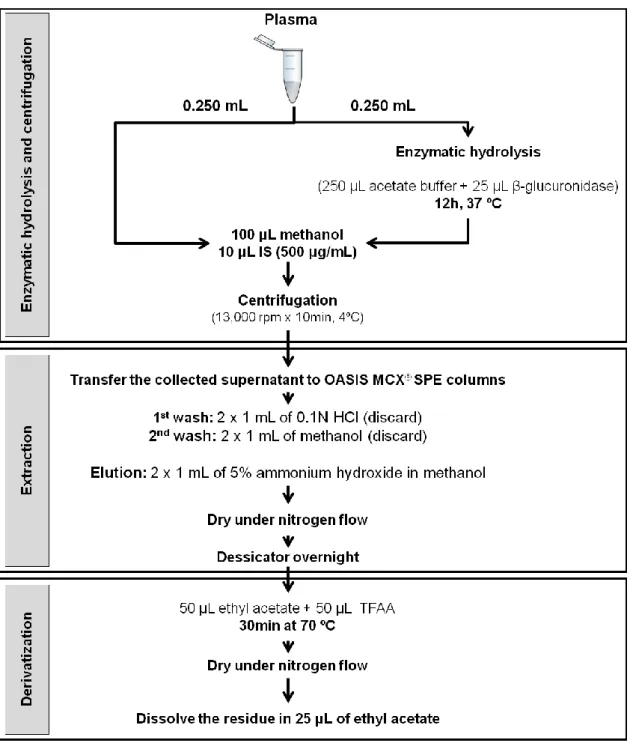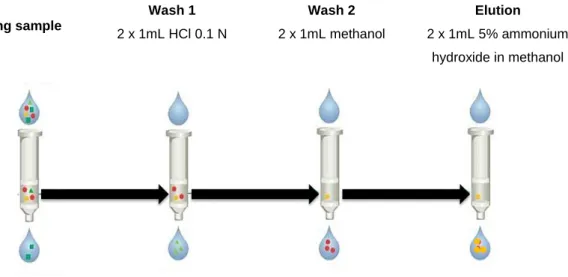Development and validation of a gas chromatography/mass
spectrometry method for simultaneous quantification of
benzylpiperazine and its metabolites: Application to a pilot
toxicokinetic study in mice
Márcia de Jesus de Sá Monteiro
Master Degree in Analytical, Clinical and Forensic Toxicology
Dissertation thesis for the Master Degree in Analytical, Clinical and Forensic Toxicology submitted to the Faculty of Pharmacy
Dissertação de candidatura ao grau de Mestre em Toxicologia Analítica, Clínica e Forense apresentada à Faculdade de Farmácia
Supervised by Professor Maria de Lourdes Pinho de Almeida Souteiro Bastos, Dr. Maria Paula Amaral Alegria Guedes de Pinho and Professor Márcia Cláudia Dias de Carvalho
Faculty of Pharmacy, University of Porto October 2012
iv
IS AUTHORIZED THE INTEGRAL REPRODUCTION OF THIS THESIS FOR
RESEARCH PURPOSES BY MEANS OF A WRITTEN DECLARATION FOR
PERMISSION OF USE.
v
“If it doesn’t challenge you,
It doesn’t change you”
vi
À minha família e amigos, em especial ao Tiago “All the darkness in the world cannot extinguish the light of a single candle.” Saint Francis of Assisi
vii
ACKNOWLEDGEMENTS
Firstly I would like to thank Professor Maria de Lourdes Bastos, Dr. Paula Guedes and Professor Márcia Carvalho for their supervision, encouragement and advice during this research. I also thanks for the revision of this thesis.
I also would to express my deep gratitude to Dr. Sónia Fraga (Laboratory of Toxicology, Faculty of Pharmacy, Porto) for her help and availability in performing the toxicokinetic assay.
I also want to express my gratitude to the Laboratory of Toxicology, Department of Biological Sciences, Faculty of Pharmacy of Porto for providing all the equipment and financial support necessary to perform all the experimental work
I thank to Professor Paula Branco and Professor Luísa Ferreira (REQUIMTE/CQFB, Department of Chemistry, Faculty of Science and Technology New University of Lisbon) for the synthesis of hydroxylated metabolites of benzylpiperazine.
I also would to thank to Professor Maria de Lourdes Bastos, Coordinator of the Master Degree in Analytical, Clinical and Forensic Toxicology.
Thanks to all the members of the Laboratory of Toxicology for all the sympathy and support expressed throughout the year, especially to “Sra Engenheira” for the candies, Vânia Vilas-Boas, Renata Silva, Luís Carvalho, Ana Oliveira and Margarida Silva.
To my friends thank for all the support. Special thanks to Ana Brandão, Patrícia Ramos, Vanessa Marques and Tânia Correia for all the friendship, encouragement and care expressed, particularly during the last few months.
Lastly, I would like to thank to my family for the motivation, support, care and dedication transmitted throughout this journey. Without their support this work would never been possible.
ix
RESUMO
A N-benzilpiperazina (BZP) pertence a um grupo compostos psicoativos sintéticos derivados da piperazina que surgiram no mercado ilícito nos últimos 20 anos. Enquanto legal, a BZP era o principal constituinte ativo das “party pills” e usada popularmente como droga recreativa devido às suas propriedades estimulantes do tipo anfetamina, tendo sido vendida como uma alternativa legal e segura a estas substâncias ilícitas.
A popularidade e o crescente consumo levaram ao aparecimento de casos de toxicidade o que, juntamente com resultados de estudos in vivo, potenciou a cessação do seu carácter legal e inclusão nas listas de substâncias psicoestimulantes controladas um pouco por todo o mundo.
É conhecido que a BZP sofre metabolismo hepático via citocromo P450 (CYP) existindo poucos estudos publicados sobre a sua toxicocinética, nomeadamente o perfil de distribuição da BZP e metabolitos nos tecidos. Por outro lado, os estudos publicados evidenciam discrepâncias entre a toxicocinética em humanos e animais (ratos
Sprague-Dawley), nomeadamente no perfil metabólico (proporção relativa dos principais
metabolitos) e no tipo de conjugados encontrados. Um estudo não publicado demonstra ainda disparidades entre as concentrações plasmáticas e teciduais da BZP e dos metabolitos maioritários. Além disso, a toxicocinética de todos os metabolitos sugeridos para esta substância não foi ainda explorada.
De forma a avaliar a disposição da BZP e metabolitos foi desenvolvido e validado um método de cromatografia gasosa acoplada a espectrometria de massa (GC-MS) que permitisse a sua quantificação simultânea. O método demonstrou seletividade e capacidade de separação da BZP e dos seus metabolitos: benzilamina, piperazina, N-benziletilenodiamina, 3-hidroxi-BZP (3-OH-BZP), 4-hidroxi-BZP (4-OH-BZP) e 4-hidroxi-3-metoxi-BZP (4-OH-3-OCH3- BZP),). De acordo com os ensaios de validação,
apresentou-se linear entre 0 - 5.000 ng/mL (R2 > 0,99) exceto para a benzilamina (R2= 0,9878), com limites de deteção (LOD) e quantificação (LOQ) a variarem entre 2 - 5 ng/mL e 7,5 – 20 ng/mL, respetivamente. A precisão, inter- e intra-day, (CV% entre 3,43 – 14,68), exatidão (100±15%) e eficiência da extração (100±20%) foram consideradas aceitáveis.
A aplicabilidade deste método ao estudo da toxicocinética foi comprovada em amostras de plasma de ratinho provenientes de um ensaio toxicocinético.
Palavras chave: BZP, metabolismo, gas chromatography-mass spectrometry, toxicocinética, ratinho.
xi
ABSTRACT
N-benzylpiperazine (BZP) has become popular among recreational users of drugs as the major active ingredient of “party pills” due to their stimulant and euphoric effects in order to improve energy, vitality and mental capacity. These pills were sold as a safe and legal alternative to amphetamines like methylenedioxymethamphetamine (MDMA,”ecstasy”).
Previous studies demonstrated that BZP undergoes hepatic metabolism via cytochrome P450 (CYP). There are only a few published studies on its toxicokinetics, namely on the disposition of BZP and its metabolites in the body. Furthermore, the available toxicokinetic studies show discrepancies between humans and animals (Sprague-Dawley rats), namely in the main metabolite and type of conjugates found. On the other hand, in the literature there is only reference to an unpublished work about the disposition of BZP and its two main metabolites, 4-hydroxy-BZP (4-OH-BZP) and 3-hydroxy-BZP (3-OH-BZP), in rats which reports a disparity in plasma and tissue concentrations of this drug and the kidneys as the tissue with the highest concentration of the drug. However, no study has been published which evaluates the toxicokinetics of all the metabolites proposed for this substance.
In order to assess the toxicokinetics of BZP in mice a gas chromatography-mass spectrometry (GC-MS) method was developed and validated. The method demonstrated selectivity and ability to resolve all the compounds (BZP, 4-OH-BZP, 3-OH-BZP, 4-OH— 3-OCH3-BZP, benzylamine, piperazine and N-benzylethylenediamine). In the validation
assays, the method is linear between 0 - 5,000 ng/mL (R2> 0.99, except for benzylamine) and the limits of detection (LOD) and quantification (LOQ) range between 2 – 5 ng/mL and 7.5 – 20 ng/mL, respectively. The precision, inter- and intra-day (CV% between 3.43 and 14.68%), accuracy (100 ± 15%), and extraction efficiency (100 ± 20%) were considered acceptable.
The applicability of this method to study BZP toxicokinetics was demonstrated in mice plasma from the pilot toxicokinetic assay.
Keywords: BZP, metabolism, gas chromatography-mass spectrometry, toxicokinetics, mice.
xiii
INDEX
ACKNOWLEDGEMENTS
vii
ABSTRACT
xi
INDEX
xiii
ABREVIATION LIST
xvii
INDEX OF FIGURES
xix
INDEX OF TABLES
xxiii
Part I
1
General introduction
1
1.1.
“Legal highs” and the emergence of piperazine derivatives
3
1.2.
BZP: an overview
5
1.2.1.
BZP development and therapeutic relevance
5
1.2.2.
Physicochemical description and synthesis
7
1.2.3.
BZP as a recreational drug
7
1.2.3.1.
“Legal status” and evolution of the market
7
1.2.3.2.
Patterns, prevalence and motivations of use
10
1.2.3.3.
Health issues related to BZP use
14
1.2.4.
Pharmacodynamics
16
1.2.4.1.
Neuropharmacology
16
1.2.4.2.
Behavioral and physiological studies in animals
17
1.2.4.3.
Human studies
20
1.2.5.
Toxicokinetics
21
1.2.5.1.
Metabolic pathways
21
1.2.5.2.
In vitro studies
23
xiv
1.2.5.3.1.
Animals studies
24
1.2.5.3.2.
Human studies
26
1.2.5.4.
Metabolic Interactions
27
1.2.6.
Analysis
30
1.2.6.1.
Screening tests
30
1.2.6.2.
Chromatographic Techniques
31
Part II
35
Scope and objectives of the thesis
35
Part III
39
Experimental
39
Chapter I
41
Materials and Methods
41
1.
Material and methods
43
1.1.
Reagents and Standards
43
1.2.
Biological Specimens
43
1.3.
Preparation of stock and working standard solutions
44
1.4.
Preparation of plasma and urine working calibrators
44
1.5.
Sample Preparation for gas GC-MS analysis
44
1.5.1.
Enzymatic hydrolysis
45
1.5.2.
Centrifugation
45
1.5.3.
Solid phase extraction
45
1.5.4.
Trifluoroacetyl derivatization
45
1.6.
Chromatographic Equipment and Conditions
47
2.
Method validation
47
2.1.
Linearity study
48
2.2.
Limits of detection and lower limit of quantification
49
xv
2.4.
Precision
49
2.4.1.
Inter-day precision
49
2.4.2.
Intra-day precision of the apparatus
49
2.4.3.
Intra-day precision of the extraction
50
2.5.
Accuracy
50
2.6.
Extraction efficiency
50
2.7.
Evaluation of interferences and specificity
50
3.
Proof of applicability: toxicokinetic study in mice
51
3.1.
Experimental design
52
Chapter II
53
Results and discussion
53
1.
Method development
55
1.1.
Sample Preparation
55
1.1.1.
Protein denaturation
55
1.1.2.
Cleavage of conjugates
55
1.1.3.
Extraction
56
1.1.4.
Derivatization procedure
59
1.2.
IS selection and suitability
69
1.3.
Gas chromatography separation and MS quantitation
72
2.
Method validation
73
2.1.
Linearity study
73
2.2.
Sensitivity
74
2.3.
Precision
74
2.3.1.
Inter-day precision of the method
75
2.3.2.
Intra-day precision of the extraction and apparatus
75
2.4.
Accuracy
75
xvi
2.6.
Processed sample stability
76
2.7.
Selectivity
78
3.
Proof of applicability: toxicokinetic study in mice
78
Chapter III
81
Conclusions and future perspectives
81
Part IV
85
xvii
ABREVIATION LIST
3-OH-BZP 3-hydroxybenzylpiperazine 4-OH-3-OCH3-BZP 4-hydroxy-3-methoxybenzylpiperazine 4-OH-BZP 4-hydroxybenzylpiperazine 5-HT SerotoninAUC Area under the curve
BZP N-benzylpiperazine
Cl Clearance
CV% Coefficient of variation
CYP Cytochrome P450
DA Dopamine
DAD Diode array detection
DAT Dopamine transporter
EI Electron impact
EMCDDA European Monitoring Centre for Drugs and Drug Addiction
GC Gas chromatography
HPLC High-performance liquid chromatography
HCl Hydrochloric acid i.p. Intraperitoneal IS Internal standard IT Ion trap i.v. intravenous k Rate constant
LLE Liquid-liquid extraction
LC Liquid chromatography
LOD Limit of detection
LOQ Limit of quantification
M+ Molecular ion
mCPP 1-(3-chlorophenyl)piperazine
MDAA Misuse of Drugs Amendment Act
MDBP 1-(3,4-methylenedioxybenzyl)piperazine MDMA 3,4-Methylenedioxymethamphetamine MeOPP 1-(4-Fluorophenyl)piperazine MS Mass spectrometry m/z Mass-to-charge ratio NA Noradrenaline NBED N-benzylethylenediamine NH4OH Ammonium hydroxide NS Not specified oTP 1-(o-tolyl)piperazine pCPP 1-(4-chlorophenyl)piperazine pFPP 1-(4-fluorophenyl)piperazine
PPP Piperazine party pills
R2 Square correlation coefficient
SD Standard deviation
SER Serotonin transporter
SIM Selected ion monitoring
xviii
SULT Sulfotransferase
TFMPP 1-(3-Trifluoromethylphenyl)piperazine
tr Retention time
UGT Uridine diphosphate glucuronosiltransferase UHPLC Ultra-high performance liquid chromatography
xix
INDEX OF FIGURES
Figure 1: BZP (a) and its pro-drugs: EGYT-475 (b) and DIV-145 (c). ... 6
Figure 2: Main groups of psychoactive substances notified by the European
early-warning system (44). ... 10
Figure 3: Prevalence of “ever tried” party pills by age and gender (47). ... 13
Figure 4: Metabolic pathways of BZP proposed by Staack et al. (2002). ... 23
Figure 5: Urinary excretion profile of (●) BZP and its main metabolites: (■)
4-OH-BZP and (x) 3-OH-4-OH-BZP after a single intraperitonial dose of 5mg/kg (84). ... 24
Figure 6: Concentration-time plasmatic profile of BZP after a single 2 mg/kg i.p.
administration alone or in combination with TFMPP (1:1) (89). ... 25
Figure 7: Mean plasma concentrations of BZP (on the left) and its hydroxylated
metabolites (on the right) over a 24h period after a single oral administration of
200 mg BZP (n=7 healthy males) (83). ... 26
Figure 8: Total amount of BZP, 3-OH-BZP and 4-OH-BZP in 24h neat urine (on
the left) and enzyme hydrolised urine (on the right) samples (83). ... 27
Figure 9: (A) BZP and (B) TFMPP concentration-time plasmatic profile after
isolated or combined administration of BZP and TFMPP (2mg/kg, IP) (89). ... 28
Figure 10: Scheme of plasma sample preparation procedure. ... 46
Figure 11: OASIS
®MCX method for extraction of basic compounds (111). ... 57
Figure 12: Full scan chromatograms of three plasma samples with the same
concentration of the four analytes, 50,000 ng/mL, extracted with different solutions.
... 58
Figure 13: General trifluoroacetylation mechanism with TFAA to obtain the O-TFA,
N-TFA and S-TFA derivatives (117). ... 60
Figure 14: GC-MS response (mean peak area of analyte/mean peak area IS) of
plasma samples spiked with of BZP, N-benzylethylenediamine (NBED),
benzylamine (BA) and piperazine (P) at 500 ng/mL under different derivatization
conditions (volume of TFAA and temperature) with time of reaction fixed at 30 min.
For each set of conditions three independent assays were made... 61
Figure 15: Full scan and reconstructed full scan GC-MS chromatogram with
selected m/z ions of a standard solution of 4-OH-BZP after derivatization with EI
mass spectra of the mono-TFA derivative (spectrum 1A) and bis-TFA derivative
xx
(Spectrum 2A). The m/z selected were m/z= 288 for the mono-TFA derivative and
m/z= 384 for the bis-TFA derivative. ... 62
Figure 16: Full scan and reconstructed full scan GC-MS chromatogram with
selected m/z ions of a standard solution of 3-OH-BZP after derivatization with EI
mass spectra of the mono-TFA derivative (spectrum 1A) and bis-TFA derivative
(Spectrum 2A). The m/z selected were m/z= 288 for the mono-TFA derivative and
m/z= 384 for the bis-TFA derivative. ... 63
Figure 17: Full scan and reconstructed full scan chromatogram with selected m/z
ions of a standard solution of 3-OCH
3-4-OH-BZP after derivatization with EI mass
spectra of the mono-TFA derivative (spectrum 1A) and bis-TFA derivative
(Spectrum 2A). The m/z selected were m/z= 318 for the mono-TFA derivative and
m/z= 414 for the bis-TFA derivative. ... 64
Figure 18: EI mass spectra of BZP N-TFA and proposed fragmentation pattern. . 66
Figure 19: EI mass spectra of piperazine N, N-TFA and proposed fragmentation
pattern. ... 66
Figure 20: EI mass spectra of benzylamine N-TFA and proposed fragmentation
pattern. ... 66
Figure 21: EI mass spectra of N-benzylethylenediamine N-TFA and proposed
fragmentation pattern. ... 67
Figure 22: EI mass spectra of 3-OH-BZP N,O-TFA and proposed fragmentation
pattern. ... 67
Figure 23: EI mass spectra of 3-OH-BZP N-TFA and proposed fragmentation
pattern. ... 67
Figure 24: EI mass spectra of 4-OH-BZP N,O-TFA and proposed fragmentation
pattern. ... 68
Figure 25: EI mass spectra of 4-OH-BZP N-TFA and proposed fragmentation
pattern. ... 68
Figure 26: EI mass spectra of 3-OCH
3-4-OH-BZP N,O-TFA and proposed
fragmentation pattern. ... 68
Figure 27: EI mass spectra of 3-OCH
3-4-OH-BZP N-TFA and proposed
fragmentation pattern. ... 69
Figure 28: EI mass spectra of IS N,O-TFA and proposed fragmentation pattern. . 69
Figure 29: Reconstructed full scan chromatogram of (A) BZP and (B)
o-tolylpiperazine and respective mass spectra (1 and 2). The selected m/z ions were
xxi
Figure 30: Full scan IS peaks from the stability study (red chromatogram-sample
just after being prepared; green chromatogram – processed sample after 3 days;
orange chromatogram – processed sample after 5 days). ... 77
xxiii
INDEX OF TABLES
Table 1: Principal piperazine derivatives used as recreational drugs. ... 5
Table 2: Toxicokinetic parameters for BZP (2 mg/kg, i.p.) in rat (Wistar) (89). ... 25
Table 3: Human toxicokinetic parameters for BZP, 4-OH-BZP and 3-OH-BZP (83).
... 26
Table 4: Toxicokinetic parameters (mean±SD, n=3) for BZP and TFMPP in rats
(Wistar) when administered alone and in combination (89). ... 29
Table 5: Toxicokinetic parameters (approximated values) for BZP and TFMPP in
humans when administered alone or in combination (91). ... 30
Table 6: Review of the analytical methods for qualitative and quantitative analysis
of BZP and metabolites. ... 32
Table
7:
Mean
relative
extraction
recoveries
(%)
for
BZP,
N-benzylethylenediamine (NBED), benzylamine and piperazine. ... 59
Table 8: Response (peak of analyte/peak of IS) under different derivatization
conditions. ... 60
Table 9: Retention times and selected ions (m/z) used for the identification and
quantification of the analytes. ... 73
Table 10: Calibration curves for BZP, benzylamine, piperazine and
N-benzylethylenediamine (NBED) in plasma (n=3). Values presented correspond to
mean±(SD). ... 74
Table 11: LOD and LOQ values in ng/mL for BZP, benzylamine, piperazine and
N-benzylethylenediamine (NBED) in plasma. ... 74
Table 12: Inter-day precision of the method for the determination of BZP,
N-benzylethylenediamine (NBED), piperazine and benzylamine (n=3). ... 75
Table 13: Intra-day precision of the extraction method and apparatus for BZP,
N-benzylethylenediamine (NBED), benzylamine and piperazine at a concentration of
1,000 ng/mL. ... 75
Table 14: Accuracy (%) for the determination of BZP, N-benzylethylenediamine
(NBED), benzylamine, and piperazine (n=3). ... 76
Table 15: Extraction efficiencies (%) for the determination of BZP,
N-benzylethylenediamine (NBED), benzylamine and piperazine in plasma (n=3). ... 76
Table 16: Inter-day coefficients of variance (CV%) from the stability of the
processed plasma samples. ... 77
xxiv
Table 17: Inter-day coefficients of variance (CV%) from the stability of the
processed plasma samples without correct the signal with IS. ... 78
Table 18: Concentration of BZP and metabolites (ng/mL) in mice plasma from a
pilot toxicokinetic study. ... 78
xxv
FRAMEWORK
This thesis will be divided in the following three parts:
Part I – General introduction
This section contains a review about BZP, since its development as a potential antihelminthic drug and the evaluation as an antidepressant until its use as a recreational drug of abuse due to its stimulant properties. The characteristics of its recreational use are also referred, namely the “target population”, patterns and motivations of use, and evolution of its legal status. Moreover, the in vivo and in vitro studies performed in order to understand its pharmacology, toxicology and toxicokinetics are also discussed. Finally, its clinical and/or forensic analysis is briefly addressed.
Part II – Scope and objectives of the thesis
In this section the aims of this thesis will be presented and discussed.
Part III – Experimental
This section will be divided into three chapters: Chapter 1: Materials and methods
This chapter describes all the reagents, biological specimens and techniques used to perform the development and validation of a gas chromatography-mass spectrometry (GC-MS) method and the pilot pharmacokinetic study of BZP in male Charles-River CD1 mice after a single intraperitoneal (i.p.) administration of 20 mg/kg and 50 mg/kg BZP (in saline). The method was developed and validated for the detection and quantitation of BZP and its identified metabolites (3-OH-BZP, 4-OH-BZP, 4-hydroxy-3-methoxy-BZP, piperazine, N-benzylethylenediamine and benzylamine) in human plasma.
Chapter 2: Results and discussion
In this chapter the results obtained both during the validation of the GC-MS method and the pharmacokinetic study are presented and discussed.
Chapter 3: Conclusions and future perspectives
This chapter presents the final conclusions resulting from the experimental work and future perspectives.
Part I
3
1.1.
“Legal highs” and the emergence of piperazine derivatives
Drug use remains a global problem and, over the years, there have been an emergence on new unregulated psychoactive compounds. These substances are known and marketed as “legal highs” or “herbal highs” and include a wide variety of natural (herbal), semisynthetic and synthetic substances which are designed to circumvent drug controls and mimic psychoactive effects of illicit drugs. “Legal highs” are available in a variety of formulations and are mainly purchased on internet websites or from street retailers (smart shops or head shops) (1, 2). These substances have experienced a rapid increase in popularity mostly attributed to aggressive web-based marketing (2, 3) but also to associations with street illegal drugs (e.g. names and symbols/logos) (4).
The “legal high” market has a singular characteristic because after a ban of a particular substance, novel compounds quickly appear (in order to evade the law), and are advertised as being better than the previous ones (2, 5). It should be noted that the vast majority of these novel drugs have not been tested for their safety (lack of pharmacological and toxicological information) and, as they are not covered by any drug legislation or control, the potential health implications of their use are largely unknown and difficult to predict (2, 6, 7). The use of these products is normally based only in other users’ opinions (2, 3) and on the market advertisement, which, usually, doesn’t refer the presence of psychoactive compounds on the list of ingredients (1, 3, 8), adverse effects or provide safety information like contraindications and possible drug-drug interactions (2, 3, 9). In addition, “legal highs” are frequently advertised as “air fresheners”, “herbal incenses”, “bath salts”, “plant fertilizers” and “not for human consumption” (1, 2, 10). Besides, it is still reported the inconsistency and lack of homogeneity in the composition of some “legal highs” sold over the internet (e.g., over time and between products sold by different suppliers with the same name) (8, 11, 12) and, on the other hand, some products sold as “legal” in fact contain substances already under control (11, 12), which increases the risk associated with the acquisition and use of such products.
Most of these substances have gain popularity within the “rave” party scene (recreational drugs) among young people as alternatives to illicit drugs (7, 13). Among such recreational drugs, piperazine derivatives emerged during 1990s as a completely new class of designer drugs and safe and legal alternatives to amphetamines (7). The first medical use of piperazine compounds was as antihelminthic agents, in 1950s, for the treatment of human and animal worm infections. After that, several compounds with distinct pharmacological activities appeared on the market containing the piperazine
4
moiety, namely sildenafil and vardenafil (erectile dysfunction drugs), trazodone and nefazodone (antidepressant drugs) and, clozapine and olanzapine (antipsychotic drugs) (14).
The piperazine derivatives have shown to possess psychoactive properties and were promoted as recreational drugs. According to their chemical structure, they can be divided into two groups: the benzyl- and the phenylpiperazines. The most common benzylpiperazines are the N-benzylpiperazine (BZP) and (3,4-methylenedioxybenzyl)piperazine (MDBP)); as phenylpiperazines became popular the 1-(3-trifluoromethylphenyl)piperazine (TFMPP), the 1-(3-chlorophenyl)piperazine (mCPP), the 1-(4-methoxyphenyl)piperazine (MeOPP), the 1-(4-chlorophenyl)piperazine (pCPP) and, the 1-(4-fluorophenyl)piperazine (pFPP) (table 1) (15-18). These compounds were promoted and sold, particularly via Internet websites, as free bases or salt (19), mainly as capsules, pills, tablets, and powders (17, 20). They were sold as legal alternatives to amphetamines (generally blends of piperazines) but also in tablets sold as methylenedioxymethamphetamine (MDMA; ecstasy) or amphetamine (17, 21). The presence of piperazines were also reported in formulations of other drugs of abuse, namely ecstasy and cocaine (17). Due to its legal status and possibility of legitimate promotion, the spread potential of such substances is greater than for controlled substances (21). A survey in UK, by Davies et al. (2010) where 26 “legal highs” were purchased once a month over 6 months (January 2009 – June 2009), from five different internet sites in UK, showed that piperazines were the most common seen active product in the tablets purchased.
5
Table 1: Principal piperazine derivatives used as recreational drugs.
Name Abbreviation Structure
1-benzylpiperazine BZP 1-(3,4-methylenedioxy)benzylpiperazine MDBP 1-(3-trifluoromethylphenyl)piperazine TFMPP 1-(3-chlorophenyl)piperazine mCPP 1-(4-methoxyphenyl)piperazine MeOPP 1-(4-chlorophenyl)piperazine pCPP 1-(4-fluorophenyl)piperazine pFPP
1.2. BZP: an overview
1.2.1. BZP development and therapeutic relevance
BZP was initially called and marketed over the internet and by some retailers as a “natural” product (“pepper extract” and/or “herbal high”) because of the structural similarity with piperidine, a component of the black pepper (“Piper nigrum”) despite its synthetic origin (21, 22).
BZP was first developed, in 1944, as a potential antihelminthic agent for livestock by Wellcome Research Laboratories in the UK. However, because of its lack of efficacy compared with piperazine and side-effects (namely, seizures in mammals), it was never used for that purpose (20, 22). Later, in the 1970s, it was evaluated, by the same
N NH O O N NH F F F N NH Cl N NH C H3 O N NH Cl N NH F N NH
6
laboratories, as a potential antidepressant agent due to its ability to reverse the sedative effects of tetrabenazine (dopamine depleting agent used for the treatment of involuntary hyperkinetic movement disorders such as Huntington’s Disease) in rats and mice (23, 24). However it was never marketed as an antidepressant possibly due to its similarities with amphetamines as hyperactivity and stereotypic behavior were observed after its administration to animals (22, 25). Such amphetamine-like effects, both subjective and physiological, were corroborated by in vivo studies in humans suggesting that BZP possess approximately 10% the potency of dexamphetamine (26, 27). The results of those investigations lead, for the first time, to the recommendation that BZP should be under the same regulatory measures applied to amphetamines due to its potential of abuse (26). In the 1980s, despite the previous findings and warnings, a derivative of BZP,
N-benzyl-piperazine-picolinyl fumarate (also known as piberaline or EGYT-475) was
developed by researchers at the Semmelweis University of Medicine in Hungary as an antidepressant (28, 29). EGYT-475 was manufactured and marketed as Trebilet® but the amphetamine-like properties of BZP made it unsuitable for therapeutic purposes (22, 24) and it was withdrawn following phase II clinical trials (28). Later, it was discovered in in
vitro studies that EGYT-475 was a pro-drug and that BZP (EGYT-2760) was the active
metabolite responsible for its antidepressant properties (22, 28, 30). Literature, also refers that, later, befuraline (DIV-145; 1-benzofuran-2-yl(4-benzylpiperazin-1-yl)methanone), another BZP pro-drug, was developed and trialled as an antidepressant (figure 1). This compound showed effectiveness similar to imipramine with fewer side effects however, after phase II clinical trials the clinical research appears to have been discontinued (31). In conclusion, there are no licensed medical products containing BZP in the European Union and it is assumed that this substance has no therapeutic value (4).
7
1.2.2. Physicochemical description and synthesis
BZP, also known as 1-benzyl-1,4-diazacyclohexane or N-benzylpiperazine, is a diamine with no stereoisomers (4). The substance is available as a freebase or as hydrochloride salt (BZP.2HCL). As a free base (CAS: 2759-28-6) it has a molecular formula of C11H16N2 and a molecular weight of 176.26 g/mol, and the hydrochloride salt
(CAS: 5321-63-1) has a molecular formula of C11H16N2.2HCl and a molecular weight of
249.19 g/mol (21, 28).
The base form is a pale, slightly yellowish-green viscous liquid (4, 28) which presents an acidity constant (pKa) of 9.02 (20ºC) (28) and is corrosive. The hydrochloride salt is a white solid highly soluble in water, irritant to eyes, respiratory system and skin (4, 28).
BZP is readily synthesized by the reaction of piperazine monohydrochloride and benzyl chloride, both easily available chemicals. This synthesis is significantly easier compared to other drugs such as amphetamine or ecstasy, and it seems that dibenzylpiperazine (DBZP) may be formed during the reaction as an impurity (4, 21).
1.2.3. BZP as a recreational drug
1.2.3.1. “Legal status” and evolution of the market
In the 1970s and 1980s several studies showed that BZP has a stimulant amphetamine-like effect and in the 1990s the drug became popular as a recreational drug, being the major active ingredient of “party pills” (22, 31). The abuse of BZP was first described in the USA in 1996, in California, (31, 32) although, its use remained minimal until the end of the 90s when BZP started to spread particularly among youth as a legal rave/party drug (31), particularly due to its promotion as “legal”, “natural” and “safe” (33). In fact, the promotion as “herbal pills” was perceived, particularly among youth, as a weaker and safer product due to its herbal origin unlike other synthetic “real drugs” (34). Besides the use as a recreational drug, it was also described the use of BZP as a doping agent in the field of horse racing (31) and by athletes (31, 35), where it is prohibited since January 1st, 2007, by the World Anti-Doping Agency (WADA) (36).
Although being popular in many countries including the USA, Australia, Sweden, Japan, South Africa and Bulgaria, the drug only developed a significant market as a legal drug in New Zealand since 2000 until 2008, as the main psychoactive constituent of “party pills” or “BZP-party pills” (37), also known as “piperazine party pills” (PPPs), “herbal highs” or “social tonics” (6). In fact, in New Zealand there were over 120 brands of party pills (33), and, in 2005, was estimated that approximately 150,000 doses of party pills were
8
sold each month (38). According to literature, the New Zealand entrepreneur Matt Bowden, a former methamphetamine addict, was responsible for the introduction of party pills in the market, in 1999. In fact, Matt Bowden promoted BZP as a safer and legal alternative to illicit drugs, and referred a harm minimization role to this substance helping methamphetamine addicts to overcome their addiction (31). Until 2008 this substance was legal in New Zealand and, at this time it was estimated that the party pill industry was worth NZ$50 million (approximately 27 million euros) per year (37), with the prevalence of the use of BZP exceeding the use of any other illicit drug aside from cannabis, according to several performed surveys (31).
Until 2005 there were no legal measures to control BZP, although, in 2005, following a recommendation from the Expert Advisory Committee on Drugs (EACD), BZP was the first substance to be classified as a “restricted substance” by the Misuse of Drugs Amendment Act 2005 (MDAA). At this point, BZP was made illegal to sell and supply to minors of 18 years old, and it was also prohibited the distribution of free samples besides television and print advertisement. Later, after the review of the epidemiologic and pharmacotoxicologic evidences, it was determined that BZP constituted a “moderate risk” and, on April 1st 2008, BZP and other related piperazines were reclassified as Class C1 (similar to cannabis) and made ilegal to manufacture, import, export, supply, sell, and consume by the MDAA 1975 (31, 37). It is referred that other legal drugs, such as 1,3-dimethylamylamine (DMAA) (37, 39), mephedrone and diphenylprolinol (D2PM) have taken much of the party pill market in this country (5).
Similar to what happened in New Zealand, BZP started to be placed under control around the world, namely in the USA (since 2002), Australia and Japan (since 2006) (37).
The size of the BZP market beyond New Zealand is less known, being reported sporadic seizures of BZP-party pills in the European Union (37), where it was first noted as a drug of abuse in Sweden in 1999 (40). At this time, BZP was added to the “Early Warning System”, a system designed to monitor new potential drugs of abuse (31). However, its widespread as a recreational drug in Europe only occurred in the second half of 2004 (4), and there has been an increase in the number of notifications to the European Monitoring Centre for Drugs and Drug Addiction (EMCDDA) and Europol relating to it by the end of 2006 (41). Between 2005 and 2007, formulations with BZP, mainly tablets and capsules, were extensively sold in smart shops, through websites and even in music festivals (42). During this period, despite the lack of control, seizures of BZP in powder, capsule or tablets were reported in 13 EU Member States (including Belgium, Denmark, Finland, France, Germany, Greece, Ireland, Malta, the Netherlands, Portugal, Spain, Sweden and the United Kingdom) and in Norway (4). The United Kingdom and Sweden were the two countries with the largest number and size of seizures (4, 41). Among tablets
9
seized the “Mitsubishi” and “Smiley Face” design were common, which may explain the BZP seizures before any regulation and the probable sale and acquisition of BZP, at least in part, as ecstasy (4). In fact, there was reported the acquisition of pills as being ecstasy pills when, in fact, they contained BZP (43).
The growing concerns around this psychoactive substance led to a formal request for risk assessment in 2007 (41), despite some Member States (Belgium, Denmark, Greece, Malta and Sweden) already control BZP under drug control measures, Spain and the Netherlands regulate BZP under medicine-related legislation, and, at this time, in Ireland the sales were proihibited to the under 18 years (41). The BZP risk assessment reported the lack of information on the pharmacological and toxicological effects of such substance in humans, its activity as a central nervous system stimulant (CNS), and the possible interindividual variability in the expression of its toxicity due to genetic polymorphisms in metabolizing enzymes and interactions with other drugs. Consequently, it was recommended the establishement of appropriate control measures in the Member States (4). Later, in March, 2008 it was published the Decision of the Council of Europe that all Member States should apply to BZP control measures, accordingly to national legislation and the reduced risks known until date, within one year (42).
Since this decision the availability of BZP in Europe appears to have decreased, despite some Member States continue to report its availability in 2009 and 2010 (figure 2) (1, 44). In fact, some works reported the presence of BZP and TFMPP, already under control, in legal highs sold by UK online legal highs retailers (8, 11). Furthermore, the combination of different substances in powders and tablets, and also the combination of BZP and other piperazines with other well-known drugs, such as amphetamine and
ecstasy, is partly responsible for the increasing dificulty in the interpretation of the
10
Figure 2: Main groups of psychoactive substances notified by the European early-warning system (44).
In Portugal, the first news about this recreational drug are from June 2006, although it has not been found any information about specific cases of seizures in our country. Thus, in June 2nd, 2006, the “Jornal de Notícias” published online about the possibility of BZP to be synthesized from a medical substance available for the treatment of intestinal parasitic infections (www.jn.pt/PaginaInicial/Interior.aspx?content_id=675149). Later, in 2009, BZP integrated the controlled substances in accordance with the legal requirements applicable to trafficking and consumption of narcotic drugs and psychotropic substances approved by Decree-Law 15/93 de 22 of January, through Law No. 18/2009 , May 11, that proceeds to the 16th amendment of cited Decree-Law. BZP was then added to Table II-A being subject to the same control measures of other well-known illicit substances, including GHB, ecstasy, mescaline, lysergic acid diethylamide (LSD) and psilocybin (45).
1.2.3.2. Patterns, prevalence and motivations of use
Due to its legal widespread market in New Zealand, most of the knowledge concerning the use of BZP-party pills comes from this country. BZP is commonly swallowed in capsule or tablet form, although it is also reported the snorting of the powder as well as its mixture in drinks or swallow wrapped in cigarette paper (“hummer”) (34, 46, 47) and the intravenous (i.v.) use, in an attempt to a faster onset of the action. The i.v. administration of BZP was reported by the users as being painful due to the alkalinity of the solution (pH≥12) (20).
11
BZP was sold and consumed in products more commonly known as “Legal X”, “Herbal ecstasy”, “Legal E” and “A2” (4, 48), and was marketed under different brand names (for example, “P.E.P. pills”, “Jump”, “Euphoria”, “Rapture”, “Frenzy”, and “Charge”) (4, 37, 49). With the increasing popularity of party pills, the combination of BZP with other psychoactive substances, such as other piperazines (mainly, TFMPP, mCPP and MeOPP), increased (29, 38, 50), in addition to other ingredients like caffeine, herbal extracts, amino acid and electrolyte blends, in order to enhance its positive effects (29, 46, 51) or diminish the side effects (for example, l-tyrosine as a precursor of dopamine in order to ameliorate any dopamine depletion due to the consumption of such pills) (29). The combination of BZP with TFMPP was the most popular combination of piperazines in party pills, and is reported by the drug users that the consumption of this combination is an attempt to mimic the MDMA effects (17, 19, 51, 52). In fact, the effects of TFMPP in the release of serotonin (5-HT) are suggested as being responsible for the hallucinogenic effects attributable to pills containing such mixture in addition to the stimulant and euphoric proprieties of BZP (52, 53). Furthermore, in mice, the combination (BZP+TFMPP) has been shown to have similar effects to MDMA in the release of dopamine (DA) and 5-HT (52). In these pills the ratio of BZP to TFMPP can range from 2:1 to 10:1 (30, 54). It is still referred its combination with other illicit substances such as amphetamine, ecstasy, cocaine and ketamine, to enhance its stimulant and euphoric effects (17, 21). Furthermore, nevertheless the advertising from the retailers to avoid the combination of party pills with alcohol, medicines and other drugs (46, 47, 55), surveys conducted in New Zealand found that most party pills users consumed it in combination with other psychoactive substances, particularly alcohol, ecstasy, cannabis,
amphetamines and nitrous oxide (46, 47, 49). Such surveys also revealed that the combinations of party pills with other substances often had specific roles, such as: (i) increase or extend the stimulant effects; (ii) allow a greater intake of alcohol since it is reported that party pills increase sobriety (46, 47); (iii) allow to deal with the negative effects of party pills (for example, cannabis to relax, stimulate appetite and sleep) (46). Besides cannabis, tobacco, and alcohol the so-called “recovery pills” are also used with this purpose. “Recovery pills” contain 5-hydroxytryptophan (5-HTP) and have been sold, sometimes in the same packs, and marketed as being able to reduce the adverse effects of party pills as it is converted to 5-HT in the brain (47, 49). Some authors also suggest that as BZP and 5-HTP increase the levels of 5-HT it may increase the risk of adverse side effects as occurs with ecstasy (49).
The growing popularity as well as the emergence of several brands was accompanied by an increase in the amount of BZP content (30, 33, 55), with the typical dose of BZP ranging between 50 and 200 mg (29, 30, 49). There are also references to party pills
12
containing higher quantities, up to 1000 mg, though it was not a common scenario (20, 33). Some differences between what was labeled on the packages have been detected, both in the qualitative (piperazines present) and quantitative content (30, 56).
According to surveys conducted in New Zealand, the average amount of party pills consumed per occasion is approximately 2/3, although there are reports of consumption of 8 or more pills (34, 46, 47), exceeding what was usually recommended by manufacturers (“2, wait 2 h, then another 2 if tolerated”) (30). A survey (n=189) performed by Wilkins et al. (2008), revealed that the amounts of piperazine (BZP/TFMPP) taken on an occasion of greatest use ranged between 43-2500 mg, with the highest amount of participants having consumed between 100-500 mg. As the amount of BZP in party pills varies considerably between brands, the amount of BZP and other piperazines consumed depends not only on the number of party pills taken but also the strength of such pills (49). This high consumption may result in the exacerbation of toxicity and is in line with data from hospitalizations due to the intake of party pills (20). Furthermore, it seems that this high consumption may be associated to the lack of the desired effect or time that is needed to those effects occur (20, 46), as well as due to the promotion of such products as “herbal” and legal which leads the user to underestimate the strength of the products (33, 57). The amount of party pills consumed also seemed to depend on the places and context of use as well as the side negative effects (“hang-over”) already experienced by consumers (46). In fact, adverse effects are reported as one of the main reasons leading to the decrease in the use of party pills, in addition to changes in lifestyle, and seasonal variations related to the recreational environments in which these products are generally consumed (46, 47).
According to the studies performed in New Zealand the use of legal party pills was highest amongst youth and young adults (46, 47). A household survey, in 2006, revealed that, out of 2010 individuals, aged between 15 and 45 years old, the prevalence of use was higher among those aged 18-29 years, with almost 50% (48.8%) of respondents between 20-24 years having ever tried party pills (figure 3) (47). This survey, like others, showed that in almost all age groups the use was greater among males than females (34, 46, 47).
13
Figure 3: Prevalence of “ever tried” party pills by age and gender (47).
In addition, BZP-party pills users include both users of illicit drugs and legal substances from different social classes, being used in particular by high school students and university employees as well as by part- or full-time workers (34, 46, 47). Thus, unlike what occurs with the regular consumers of other type of drugs, namely illicit drugs, BZP-party pills consumers did not seem to arise from groups socially and/or economically marginalized (46).
The majority of the BZP-party pills users declared using BZP as a recreational drug due to its stimulant proprieties (increased confidence, talkativeness, euphoria, vigor and activity, and enhanced socialization) (2, 46, 47), mainly at night and weekends at dance parties or “raves” (22, 46). The studies also highlighted the similarities between the use of BZP-party pills and ecstasy, particularly, the use of other drugs and extended periods of dancing in heated environments (37, 46). Besides the recreational use of such drug, a more functional use is also reported as a means of increasing alertness and physical/mental performance among students and workers (such as shift workers and truck drivers) (37, 46). Other less common uses were also reported as for example, the use by young females as an appetite suppressant for weight loss (47).
1.2.3.2.1.
Impact of the legal status on the consumption of BZP
Studies performed in New Zealand revealed that the legal status of BZP affected its use, particularly among young people (47, 57). In fact, a study performed by Sheridan and Butler (2010), in New Zealand, showed that because BZP-party pills were legal, the users (n=58, aged between 17-23 years) had the perception that they were safe compared with illicit substances. Furthermore, many believed that the legality of these products safeguard their quality, unaware that there were no controls in the manufacturing process.
14
The presence of labels in the products also carried the perception of quality and purity and confidence that they were consuming exactly what they bought, despite the lack of any kind of assessment to which the products were subjected in order to prove the veracity of the information on the label. With respect to the strength of such pills, many respondents said that they expected that as these products were legal the psychoactive effects were moderate. Additionally, the legalility provided an easier access to these products and the lack of criminal behaviour unlike what happens with illicit drugs (57).
In conclusion, the legal status conveyed the perception of quality, safety, lack of criminal activity, and expection that the psychoactive effects were relatively mild. Furthermore, being legal these products were widely available and socially accepted/legitimate to use (57). All these factors with their promotion as a legal and safe alternative to other drugs were motivating factors for BZP-party pills consumption (57).
According to that, BZP-party pills, while legal, may acted both as a “gateway” to illicit substances or as a harm reduction “player” with illegal drug users taking BZP instead of illicit drugs (29, 37, 47). Nevertheless, the real impact of BZP-party pills legality and prohibition in the consumption of illegal drugs is not conclusive (37, 58) and might be both positive and negative. In fact, on one hand its criminalization appears to have led to its decreased availability and consumption (31, 58, 59) both among general population and frequent drug users (58), but, on the other hand, its ban from the legal market and as a legal alternative to other drugs might conduct to a shift from BZP use to illegal drugs, to other legal substances with unknown toxicity and/or to an increased criminalization around BZP-party pills (37, 60, 61).
Apart from BZP criminalization, other factors mentioned by users as being important reasons for stopping BZP use both before and after the criminalization were the hang-over effects and physical health reasons (47, 58).
1.2.3.3. Health issues related to BZP use
Despite the misconception that BZP-party pills are safe, there are a number of case reports and clinical evidence supporting its toxicity, which is expected to be due to the similarities of this substance with amphetamines (17). Again, due to the more expressive market of this substance, the clinical experience of piperazines toxicity in New Zealand is probably the greatest (39, 48). The adverse physical symptoms most frequently reported by users are: insomnia, headaches, and nauseas (31, 47). Other negative effects reported include: dizziness, mood swings, agitation, strange thoughts, tremor, dry mouth, diaphoresis, dehydration, urine retention, xerostomia, tachycardia, bruxism and trismus,
15
mydriasis, loss of appetite, and tiredness, some of which appeared to persist for more than 24 h after ingestion (20, 46, 47).
Some more serious adverse effects have also been reported namely: metabolic and respiratory acidosis, hyponatremia, toxic seizures (20, 62), acute paranoid psychosis (32), dissociative states (43), and exacerbation of mental illness (63), hyperthermia, rabdomyolysis, disseminated intravascular coagulation, acute renal injury and multiple organ failure (13, 33, 64, 65). Overall, according to data available from clinical and users reports, most of the symptoms are characteristic of a sympathomimetic toxidrome similar to amphetamines and other sympathomimetics (28, 66).
BZP had also been related to fatalities and detected in post mortem samples (40, 66-69), although the role of BZP in the poisonings and deaths reported is difficult to evaluate due to its common use in combination with other substances (17, 37). Secondly, the fact that many clinicians were not aware of this substance; the similarities in the patterns of distribution and pharmacological effects with amphetamines; and the absence of screening tests for BZP and other new designer drugs in clinical practice can lead to the understimation of the role of such substances in poisonings (17). Furthermore, despite being accepted that higher plasma levels of BZP are related to an increased incidence of more severe side effects, such as seizures (33), serum or urine concentrations may not correlate with the severity of clinical symptoms. In fact, toxicity seems to be unpredictable with some users expressing significant toxic effects even after the ingestion of “recommended” doses, suggesting the possibility of a narrow safety margin and interindividual pharmacokinetic variation due to genetic polymorphisms and/or drug interactions (13, 28, 33). Furthermore, the environment of the rave party (heat, increased physical activity, lack of sleep, dehydration, excessive fluid ingestion, and co-ingestion of other psychoactive substances) also contribute to the toxicity associated with BZP-party pills intake (13). Women also seem to be at a higher risk due to their smaller body size compared to men (33, 49).
There is limited information on the long-term effects of BZP intake, namley its potential to induce addiction, tolerance or organic sequelae (28).
There are no specific treatment guidelines to BZP toxicity and the management of patients consists in their stabilization and supportive and symptomatic care. Depending on the symptoms, the management may include the correction of hyponatremia, hyperthermia, tachycardia, dehydration, hypertension, acid-base disturbances, and monitor of renal, muscular, cardiovascular and hepatic functions. The treatment of seizures and psychotic states may require the use of benzodiazepines and antipsychotics (20, 28).
16
1.2.4. Pharmacodynamics
1.2.4.1. Neuropharmacology
During the assessment of piberaline, Magyar et al. (1986) found that its metabolite, BZP, had the ability to potentiate the release of 3H-noradrenaline (3H-NA) from rabbit pulmonary artery, being this effect inhibited by the administration of 1-NA and clonidine, preferential agonists of presynaptic α2-adrenoreceptors (70). The first effects of BZP on
serotoninergic neurotransmission are also reported to the pharmacological assessment of piberaline and it was concluded, during these studies, that BZP blocks the reuptake of 5-HT in rats and has 5-5-HT1 receptor agonistic effects, these the mechanisms responsible for
their central serotoninomimetic action. Those studies have also shown that BZP had no effect on 5-HT2 receptors (66, 71). Some other studies also suggested that BZP has 5-HT
antagonistic properties due to its ability to antagonize 5-HT-induced contractions of rat stomach fundus, and partial agonistic properties as it induced hyperthermia in rats, effect reversed by cyproheptadine, a 5-HT antagonist (24). It was suggested that those effects on serotoninergic neurotransmission may be responsible for, at least, some of BZPs side effects, such as headaches and nausea (51).
In a more recent work, Baumann et al (2004) evaluated the neurochemical effects of BZP, MDMA, and TFMPP on transporter-mediated efflux of [3H]5-HT (serotonin transporter (SERT) substrate) and [3H]MPP+ (DA transporter (DAT) substrate) in rat synaptossomes. Additionally, they evaluated the effects of such drugs on the extracellular levels of 5-HT and DA using in vivo microdialysis in rats. According to their in vitro findings, BZP evokes DAT release of [3H]MPP+ but showed no effect on the release of [3H]5-HT mediated by SERT (unlike MDMA and TFMPP). Furthermore, the effect of BZP on DA release was antagonized by low doses of DAT selective blocker. The in vivo studiesshowed that BZP has the ability to elevate the extracellular levels of both DA and 5-HT in a dose-dependent fashion, being prevalent the effects over DA, and about 3-fold less potent than MDMA.The mixture of BZP and TFMPP (1:1 ratio) resulted in dramatic dose-related increases in dialysate DA and 5-HT, suggesting a synergistic effect on DA (at the higher dose 10 mg/kg) and additive effect on 5-HT. Such effects on monoamines neurotransmission may explain the MDMA-like properties reported to the combination of such piperazines as they mimic the known molecular mechanism of MDMA. In vitro no interactions between the two drugs were noted, suggesting a possible pharmacokinetic nature for the in vivo synergism reported (52, 72). Lastly, Nagai et al (2007), using rat brain synaptossomes showed that BZP strongly inhibits the reuptake of DA and NA and
17
has a smaller effect on 5-HT reuptake. Furthermore, BZP also showed a monoamine-releasing activity, particularly on DA and NA (73).
In conclusion, similar to what occurs for other drugs of abuse, in vitro and in vivo studies have demonstrated that BZP interferes with monoaminergic neurotransmission, both inhibiting the reuptake and stimulating the release of DA, 5-HT and NA, predominating the effects on dopaminergic neurotransmission.
1.2.4.2. Behavioral and physiological studies in animals
The first behavioral effects of BZP were reported during the assessment as an antidepressant in rats. The studies showed that BZP induces hyperactivity, involuntary head movements and reduces the reaction time in shock avoidance studies, similar to dexamphetamine (26). More recent works, in mice and rats, corroborated these first findings highlighting the powerful locomotor stimulant effects of BZP (i.p. administrations with doses ranging from 5 mg/kg to 100 mg/kg), showing that this compound produces a dose-dependent increase in ambulation and stereotypy (72, 74-76). The only available studies with primates (rhesus monkeys) also reported behavioral effects, such as hyperactivity, involuntary head movements, jaw chattering, bizarre body postures, and “fly catching” (24).
The assessment of the effect derived from chronic exposure showed that repeated exposure to BZP (20 mg/kg) induces sensitization and cross-sensitization to methamphetamine, measured as increases in hyperactivity (75). These acute and sensitized behavioral responses that have been related to increases in the dopaminergic neurotransmission, as increases in dialysate levels of DA were dose-dependent and shown a positive correlation with increases in locomotor activity and stereotypical movements (72, 75). Furthermore, stereotypy and hyperactivity have been related to increases in nigrostriatal and mesolimbic dopaminergic neurotransmission, respectively. Changes and adaptations in the dopaminergic neurotransmission induced by chronic exposition to BZP were also suggested has being implicated in the sensitization and cross-sensitization, similar to what have been suggested to other stimulant drugs (75). Thus, BZP may induce neuroadaptations that sensitize users to other drugs and potentially act as a “gateway drug” to other more harmful drugs (75).
The rewarding properties of BZP were evaluated using self-administration (24), discriminative (24, 74), and place preference methods (77). Fantegrossi et al (2005) showed that BZP induces intravenous self-administration in animals (rhesus monkeys) trained to self-administer cocaine and possesses discriminative responses similar to
18
amphetamine (24). In rats, BZP induced conditioned place preference in a dose-dependent manner (77) and, in mice, induced MDMA-like discriminative stimulus without inducing head twitch behavior (used to assess hallucinogen-like actions) (74). DA neurotransmission at the mesolimbic system has been implicated in the rewarding properties of several other psychoactive drugs (25) and, in fact, during Meririnne et al (2006) experiments, a DA D1-like receptor antagonist attenuated BZP-induced place preference. Furthermore, the involvement of serotonergic system was also suggested as a 5-HT3 receptor antagonist also attenuated the BZP-induced place preference response (77). In conclusion, similar to other drugs of abuse, BZP induces conditioned place preference, showing discriminative stimulus properties similar to amphetamine and reinforcing effects similar to cocaine. These findings in animals corroborated previous evidence in humans that suggested that BZP has abuse liability.
When assessing the similarities in acute effects on anxiety-related behavior between BZP (10 or 20 mg/kg) and methamphetamine (1 or 2 mg/kg) in hooded rats, it was not clear if the altered behavior of rats were due to an increased anxiety induced by the drug or to an increased stereotypy that interfered with the action of the drug (76). However, despite the little conclusive evidence for anxiogenic effects of BZP, its anxiogenic potential should not be overlooked as increased anxiety has been reported by BZP-party pills users (20, 47).
Due to BZP similarities with other drugs possessing serotonergic and dopaminergic agonist properties about which is known to interfere with the normal neuronal development and produce cognitive and mood deficits (78), the possible long term effects resulting from the exposition to BZP during adolescence were also evaluated. A preliminary study performed by Aitchison and Hughes (2006) in rats evaluated the behavioral consequences following the administration of BZP (10 mg/kg/day, i.p.) during P45-P55 (equivalent of late human adolescence to early adulthood), with particularly attention to its anxiogenic potential and sex-related differences. From the results (decreased social interactions, responsiveness to brightness change, and emergence from the dark into the light) of this study it was suggested the possibility of BZP interferes with the development of anxiety-related mechanisms operated by 5-HT, resulting in increased levels of anxiety in adulthood. Yet, even due to more pronounced effects of BZP on dopaminergic system, it was also referred that the behavioral effects observed may be related to the depletion of DA and thus the decreased motor activity can be a result of BZP exposure (78). In fact, abnormal dopaminergic activity has been associated with deficits in motor control and aggressiveness. Additionally, a recent work assessed the long term effects (in the periods P78-81 and P117-120) resulting from the exposure to BZP (10 mg/kg/day, i.p.) and/or ethanol (2 g/kg/day, i.p.) during adolescence (P41-50),
19
and there were not find statistically significant differences between treated animals and controls (25). Nevertheless these non consistent results it was highlighted that BZP exposure, particularly during adolescence, can have long-term outcomes.
In literature is also cited that BZP induces hyperthermia when administered to rats at an ambient temperature of 28ºC (79). This effect has been related with the action of 5-HT on the thermoregulatory centre within the hypothalamus, and is probably directly related with the dose and the room temperature as seen with other drugs with hyperthermic and hypothermic effects (80, 81)
1.2.4.2.1.
Combination with other substances
Due to the frequent combination of BZP with other substances by users, the assessment of the effects of these combinations is essential to assess the safety of BZP, given that resembles the real context associated with their consumption.
During the study of Baumann et al. (2004) it was noted that, in contrast with BZP, the mixture of BZP plus TFMPP (1:1) did not produced robust locomotor stimulation and, at the high dose (10 mg/kg, i.v.) the motor stimulant effects were suppressed with several rats developing seizures and ataxia. Despite the seizures were short-lived and all animals recovered completely, the dose which caused these effects (10 mg/kg BZP + 10 mg/kg TFMPP, i.v.) was only about three times higher than that required for the effects on monoaminergic neurotransmission were visible, which suggests a narrow window of safety. It has been suggested that the suppression of BZP psychomotor properties by TFMPP is due to its properties at a postsynaptic level on serotonergic neurotransmission (52, 72).
The reinforcing properties of the mixture were also evaluated in rhesus monkeys and the reinforcing effects of BZP when combined with TFMPP were less pronounced than with BZP alone, decreasing with the increase in the concentration of TFMPP. In this same study, TFMPP alone had not discriminative nor self-administration properties. These results were in accordance with results observed with other hallucinogenic drugs, being suggested that agonistic action at 5-HT2c receptors suppresses dopaminergic activity at
the mesolimbic system (24).
Perry (2008) also evaluated the long-term effects of the exposure to BZP in combination with alcohol during adolescence in rats without, however, showing statistically significant differences between the three groups (animals treated with BZP; BZP + ethanol; ethanol) (25).
